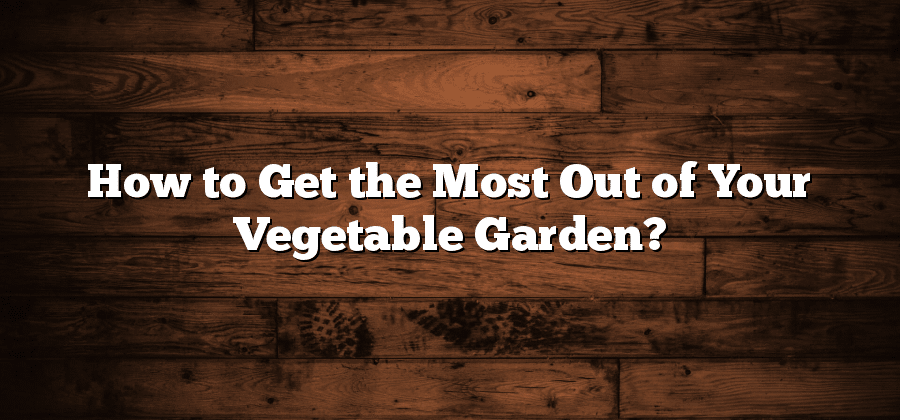Choosing the Right Vegetables for Your Garden
When it comes to choosing the right vegetables for your garden, it is important to consider several factors. First and foremost, consider the climate and growing conditions in your area. Different vegetables thrive in different climates, so it is essential to choose vegetables that are well-suited to your specific location. Research which vegetables are known to thrive in your climate and ensure that you select varieties that are suitable for your region.
Another important factor to consider when choosing vegetables for your garden is your personal preference and dietary needs. Think about the vegetables that you and your family enjoy eating the most, as this will make your gardening experience more enjoyable. Additionally, consider any dietary restrictions or specific health goals you may have. For example, if you are looking to incorporate more leafy greens into your diet, opt for vegetables like spinach or kale. On the other hand, if you are a fan of hearty root vegetables, consider planting carrots or potatoes. By choosing vegetables that align with your taste preferences and nutritional needs, you are more likely to find success in your gardening endeavors.
Preparing the Soil for Optimal Growth
One of the key factors in achieving optimal growth for your garden is preparing the soil. Before you begin planting, it’s crucial to ensure that your soil is well-nourished and in the best condition to support plant growth.
Start by removing any debris, rocks, or weeds from the area you plan to cultivate. This will help create a clean and clutter-free environment for your plants. Next, loosen the soil using a garden fork or tiller, breaking up any compacted areas. This will improve aeration and drainage, allowing the roots to penetrate the soil more easily. Incorporating organic matter, such as compost or well-rotted manure, into the soil will also provide essential nutrients and improve its overall structure. Remember to mix in the organic matter thoroughly to distribute the nutrients evenly. By taking the time to prepare your soil properly, you are setting a strong foundation for healthy plant growth.
This is just the beginning of the journey to a successful garden. The next step will be to implement effective watering techniques to provide your plants with adequate moisture.
Implementing Effective Watering Techniques
One of the key elements in ensuring the success of your garden is implementing effective watering techniques. Water is a vital necessity for plants, as it provides them with the hydration they need to grow and thrive. However, it is important to understand that not all plants require the same amount of water, and over- or under-watering can have detrimental effects on your garden.
To ensure that your plants receive the correct amount of water, it is crucial to water them at the proper times. Early morning is generally the best time to water your plants, as it allows the water to penetrate the soil and be absorbed by the roots before the sun gets too hot. Watering in the evening can cause issues with moisture retention and promote fungal growth. Additionally, avoid watering on windy days, as the water may evaporate quickly or be blown away from the plants before it has a chance to reach their roots.
Providing Adequate Sunlight for Your Plants
One of the most important factors in ensuring the success of your garden is providing adequate sunlight for your plants. Sunlight is crucial for their growth and development, as it is the primary source of energy they use for photosynthesis. Without sufficient sunlight, plants may become weak, leggy, and more susceptible to disease.
When choosing a location for your garden, consider the amount of sunlight that area receives throughout the day. Most vegetables require a minimum of 6 to 8 hours of direct sunlight to thrive. Keep in mind that different plants may have varying sunlight requirements, so it’s essential to research the specific needs of the vegetables you plan to grow. Observe the sunlight patterns in your garden throughout the day, taking note of any areas that may be shaded by trees or buildings. By selecting a spot with optimal sunlight, you can set your plants up for success from the very beginning.
Controlling Weeds and Pests Naturally
One of the challenges that every gardener faces is dealing with weeds and pests. These unwanted intruders can wreak havoc on your precious plants and hinder their growth. However, there are natural methods that can help you effectively control these nuisances without relying on harmful chemicals.
When it comes to weeds, prevention is key. By regularly inspecting your garden and promptly removing any weeds that appear, you can prevent them from taking over. Mulching around your plants can also discourage weed growth by smothering them and blocking sunlight. Additionally, using organic weed control methods such as hand-pulling or using vinegar-based herbicides can help keep your garden weed-free.
Pests, on the other hand, can pose a threat to both the health and yield of your plants. To naturally control pests, it’s important to maintain a healthy garden ecosystem. This involves keeping the soil fertile and well-drained, as healthy plants are less susceptible to pest infestation. Introducing beneficial insects, such as ladybugs and praying mantises, can also help keep pests in check. Furthermore, companion planting, where you strategically plant certain crops together to repel pests, can be an effective natural deterrent.






